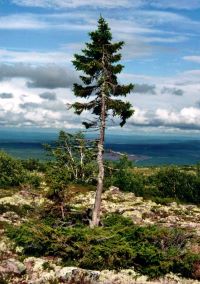
21 Jul 2020

https://ec.europa.eu/jrc/en/research-topic/forestry/qr-tree-project/norway-spruce
The data used in this example are derived from the R package Functions and Datasets for “Forest Analytics with R”.
According to the documentation, the source of these data are: “von Guttenberg’s Norway spruce (Picea abies [L.] Karst) tree measurement data.”

The documentation goes on to further note that:
“The data are measures from 107 trees. The trees were selected as being of average size from healthy and well stocked stands in the Alps.”
. use gutten.dta, clear
site Growth quality class of the tree’s habitat. 5 levels.
location Distinguishes tree location. 7 levels.
tree An identifier for the tree within location.
age.base The tree age taken at ground level.
It might be best to use a centered age variable, centered at the grand mean of tree age:
. egen ageMEAN = mean(age_base)
. generate ageCENTERED = age_base - ageMEAN
height Tree height, m.
dbh.cm Tree diameter, cm.
volume Tree volume.
age.bh Tree age taken at 1.3 m.
tree.ID A factor uniquely identifying the tree.
Roberts et al. (2015) explain that there are multiple competing perspectives, and formulas, for calculating an estimate of \(R^2\) for multilevel models.
Here we adopt an approach advanced by Cox (link below).
mixed y x1 x2 x3 || id:predict yhatcorr y yhat. mixed height age_base site i.location || tree_ID:
Performing EM optimization:
Performing gradient-based optimization:
Iteration 0: log likelihood = -3050.2621
Iteration 1: log likelihood = -3050.2621
Computing standard errors:
Mixed-effects ML regression Number of obs = 1,200
Group variable: tree_ID Number of groups = 107
Obs per group:
min = 5
avg = 11.2
max = 15
Wald chi2(8) = 8663.47
Log likelihood = -3050.2621 Prob > chi2 = 0.0000
─────────────┬────────────────────────────────────────────────────────────────
height │ Coef. Std. Err. z P>|z| [95% Conf. Interval]
─────────────┼────────────────────────────────────────────────────────────────
age_base │ .2143496 .0023831 89.95 0.000 .2096789 .2190203
site │ -3.866312 .1608021 -24.04 0.000 -4.181478 -3.551145
│
location │
2 │ -.5436647 1.247694 -0.44 0.663 -2.989099 1.90177
3 │ .5090705 .6487789 0.78 0.433 -.7625129 1.780654
4 │ .0954239 .7056685 0.14 0.892 -1.287661 1.478509
5 │ -.0590126 .5182994 -0.11 0.909 -1.074861 .9568356
6 │ .2078246 .6884815 0.30 0.763 -1.141574 1.557224
7 │ -1.210496 .7524348 -1.61 0.108 -2.685241 .2642491
│
_cons │ 12.27241 .5513051 22.26 0.000 11.19187 13.35294
─────────────┴────────────────────────────────────────────────────────────────
─────────────────────────────┬────────────────────────────────────────────────
Random-effects Parameters │ Estimate Std. Err. [95% Conf. Interval]
─────────────────────────────┼────────────────────────────────────────────────
tree_ID: Identity │
var(_cons) │ 2.106718 .3939037 1.460337 3.039204
─────────────────────────────┼────────────────────────────────────────────────
var(Residual) │ 8.397623 .359 7.722667 9.131569
─────────────────────────────┴────────────────────────────────────────────────
LR test vs. linear model: chibar2(01) = 127.84 Prob >= chibar2 = 0.0000
. predict yhat if e(sample) // calculate predicted values (option xb assumed)
We then obtain the correlation of y and \(\hat{y}\), the observed and predicted values.
. corr height yhat
(obs=1,200)
│ height yhat
─────────────┼──────────────────
height │ 1.0000
yhat │ 0.9364 1.0000
So our estimate for \(R^2\) is .93636423 squared, or .87677798.
Cox, N. J. (n.d.). Stata FAQ: Do-it-yourself R-squared. Retrieved May 7, 2020, from https://www.stata.com/support/faqs/statistics/r-squared/
Roberts, J. K., Monaco, J. P., Stovall, H., & Foster, V. (2015). Explained Variance in Multilevel Models. In Handbook of Advanced Multilevel Analysis. https://doi.org/10.4324/9780203848852.ch12